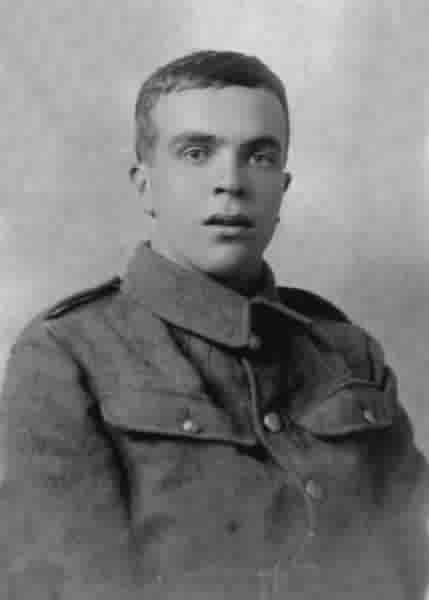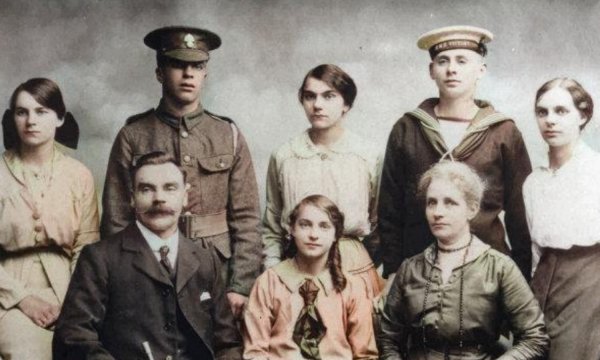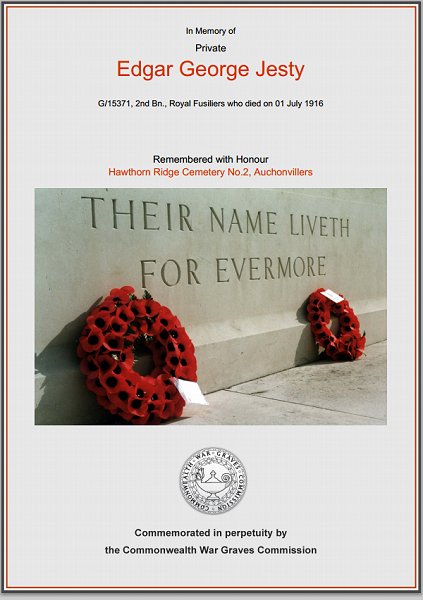yeovil at War
Edgar George Jesty
Killed in action on the first day of the Battle of Albert
 Edgar George
Jesty was born in
Yeovil in 1897,
the son of
Timber Merchant
George Ernest
Jesty (b 1868)
and Mary
Elizabeth née
Tutchings. In
the 1901 census
George and Mary
were listed at
29
Earle Street
with their
children Dorothy
(b1892),
Winifred (b
1895), 3-year
old Edgar, Olive
(b 1900) and
Hilda (b 1901).
By 1911 the
family were
living at 57
Earle Street and
14-year old
Edgar was
working as an
Errand Boy at a
Hotel.
Edgar George
Jesty was born in
Yeovil in 1897,
the son of
Timber Merchant
George Ernest
Jesty (b 1868)
and Mary
Elizabeth née
Tutchings. In
the 1901 census
George and Mary
were listed at
29
Earle Street
with their
children Dorothy
(b1892),
Winifred (b
1895), 3-year
old Edgar, Olive
(b 1900) and
Hilda (b 1901).
By 1911 the
family were
living at 57
Earle Street and
14-year old
Edgar was
working as an
Errand Boy at a
Hotel.
The family then emigrated to Canada but, following the outbreak of war, Edgar and his father George retutned to England "to do their bit" at the Woolwich Arsenal - both in reserved occupations. However it appears that Edgar, while passing through Salisbury on a train, was presented with a white feather - a sign of cowardice - by a young woman. Following this, Edgar quit his 'Home Front' job and volunteered for active service.
Edgar's military career is a bit sketchy - he initially enlisted at Yeovil in the Royal Field Artillery (Service No 86593) but was then posted to the 2nd Battalion, Royal Fusiliers (Service No G/15371). His transfer was most likely around the time that the Battalion arrived in France from Egypt in March 1916.
Also known as the City of London Regiment, the Royal Fusiliers raised no fewer than 47 battalions for service in the Great War. This makes it the fifth largest after the London Regiment, Northumberland Fusiliers, Middlesex Regiment and King's (Liverpool Regiment).
Edgar's service history is unclear but he was killed in action on the first day of the Battle of the Somme.
The Battle of Albert, 1-13 July 1916, is the official name for the British efforts during the first two weeks fighting of the First Battle of the Somme. As such it includes the first day of the Somme, the most costly day in British military history and one that has coloured our image of the First World War ever since. The Battle of the Somme had been intended to be a big Anglo-French assault on the centre of the German lines but, by the time the battle began, it turned into a largely British affair, with support from the French Sixth Army on the Somme itself. The artillery bombardment began seven days before the infantry were due to go in. It was not as effective as had been hoped, leaving large portions of the German front line intact. The German lines on the Somme contained a large number of deep concrete bunkers, which protected the Germans from the British bombardment, allowing them to emerge once the bombardment ended. Worse, along most of the British front the bombardment failed to destroy the German wire.
The attack on 1
July 1916 was made by
eleven divisions
along a fourteen
mile front from Montauban to
Serre. Haig
hoped to capture
the German front
line along this
entire front,
then break
through their
second and third
lines, before
turning left and
rolling up the
German lines to
the sea. This
would prove to
be the most
ridiculously
optimistic plan.
Along the
northern two
thirds of the
front virtually
no ground was
taken. A few
indents were
made in the
German front
lines, but they
were impossible
to extend and
difficult to
support. The
British suffered
57,000
casualties on 1
July, the most
costly single
day in British
military
history.
Thirteen
divisions at
full strength
contained
130,000 men, so
the British
suffered over
40% casualties
in a single day.
Among these was
Edgar Jesty who
died, aged 19,
on 1 July 1916.
Edgar was interred in Hawthorne Ridge Cemetery No 2, Auchonvillers, Grave B5. His name is inscribed in the Somerset County Roll of Honour in St Martin’s Chapel, Wells Cathedral and his name is recorded on the War Memorial in the Borough.
gallery

Edgar George
Jesty
(1897-1916)

A happy, smiling bunch, the Jesty family, with Edgar in uniform of the Royal Fusiliers, in a colourised photograph of 1916. (The sailor was a cousin).

The Commonwealth War Graves Commission certificate in memory of Edgar Jesty.